Actually, Resident Evil 4 Was Plenty Scary
On its 15th anniversary, we remember some of Resident Evil 4's scariest moments.
This article first appeared on USgamer, a partner publication of VG247. Some content, such as this article, has been migrated to VG247 for posterity after USgamer's closure - but it has not been edited or further vetted by the VG247 team.
I don't make a habit of playing scary video games. I was always the kid who shied away from horror movies and haunted houses. I had no interest in feeling my pulse jump as some hideous monster stalked me in the shadows. Call me the opposite of an adrenaline junkie.
But I do have a certain fascination with the mechanics of horror. I won't sit in a darkened theater and watch It Follows, but I'll often read about the best scenes just to know what happens. I have a huge amount of admiration for the true horror masters, as they're the ones who can tap into the darkest reaches of our imaginations without resorting to cheap jump scares. They understand the power of timing, of lighting, of claustrophobia. They're some of the best filmmakers we have.
I'm not sure if it was that sense of admiration that drove me to pick up Resident Evil 4 in early 2005, or if it was just the incredible hype it was enjoying at the time. Resident Evil 4 certainly remains one of the most popular and influential Resident Evil games ever made. Today, it's still seen as the game that redefined third-person action games. It was so good that even a wimp like me needed to play it.
There are a lot of fans who would contend that it's not actually that scary, though. Whenever anyone levels criticism against Resident Evil 4, it's usually to say that it's not frightening enough; as if offing a villager with a headshot, only to have a horrifying parasite burst from their neck stump, somehow isn't supremely effed up. The argument goes that in getting rid of the original game's limitations and focusing more on setpieces, Resident Evil 4 did away with the tension that defined the original entries. In that respect, Resident Evil 4 went from survival horror to an action game with horror elements, or something like that.
But as I look back on Resident Evil 4 on its 15th anniversary, I say in response: "Nah, Resident Evil 4 could actually be pretty darn terrifying." And that's what ultimately set it apart from some of its lesser sequels.
The Village
Let's start with the opening, which sees Leon Kennedy trapped in a mysterious village in which the inhabitants are all bent on killing him. It's one of gaming's most famous intros—the one section that everyone remembers best about Resident Evil 4.
The village is a masterpiece of tension and pacing, expertly establishing Resident Evil 4's mood and setting. Everything is grimy and washed out; your driver has been casually impaled over a bonfire, and the villagers are wandering about as if in a trance. It's all very mysterious: What is going on? What's wrong with the villagers? Are they zombies? Something worse?
This nervy introduction soon escalates into one of the most intense sequences in gaming history. Before you know it, you're barricaded into a house as villagers climb in through the window and bang at the door. A maniac wearing a burlap bag charges you with a chainsaw, and if they catch you off-guard, or you get your timing wrong, Leon's head is swiftly removed from his shoulders.
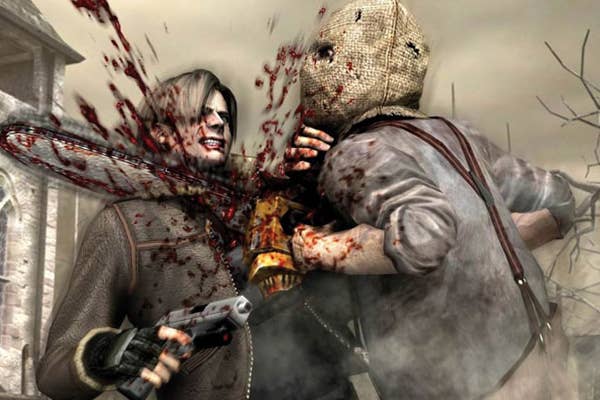
The breathless, chaotic panic this induces still fascinates me. Games by their nature are carefully structured experiences, which makes it difficult to replicate the sense of unmoored terror that this sequence produces. I think the closest I've come to that feeling since is in PUBG, in which my heart would race as I listened to a car pull up to the house where I was taking refuge, keenly aware that I would die if discovered.
Kevin Wong wrote of this sequence for Kotaku, "Too often, opening levels in video games feel detached from what comes afterwards. They are glorified, pedantic tutorials—we are babied and unchallenged for the first thirty minutes of a game, or more. Resident Evil 4 did exactly the opposite. The developers dumped us into a challenging sequence with little ammo, and told us to figure it out. It was a brilliant tactic—one that works particularly well in the horror genre, which aims to make its audience feel vulnerable and unsafe at all times."
You could argue that the breathless run through the village is actually Resident Evil 4's apex. It's director Shinji Mikami's thesis statement. Horror is amplified by the unknown, and there's nothing quite like the moment you blunder into the village for the first time, completely in the dark as to what's going on.
Resident Evil 4 necessarily falls into more conventional territory as the story progresses, though it was certainly incredible for the time. In some ways it's reminiscent of Metal Gear Solid, which also features a lone protagonist sneaking through an enemy fortress. Resident Evil 4 even has its own version of a codec. Still, it manages to weave in many of the gross-out horror the series is known for. The first time you see a Plaga is suitably horrifying—you think you've quickly dispatched an opponent, only for a wriggling mass of tentacles to burst forth as the corpse continues to shamble forward. It instantly lets you know that something profoundly bizarre is going on, all while deepening the overall mystery.
Much later, you battle Salazar, a somewhat ridiculous figure clad in a tri-corner hat who is guarded by two figures with dark cloaks and glowing red eyes. Salazar eventually transforms into a Cronenbergian horror by merging with the Queen Plaga—a perfectly disgusting sequence that puts an exclamation point on Resident Evil 4's body horror themes. Such moments are common in Resident Evil games, since pretty much every villain turns into shambling horror with way too many eyes at one point or another. It goes to show that Resident Evil 4 doesn't stray too far from its roots.
The Island
About three-quarters of the way through Resident Evil 4's story, you find a mysterious island. You soon learn that Resident Evil 4's main villain conducted his most gruesome experiments in this location, and what follows is an area that might even top the village for sheer fright. It's home to its scariest enemies, and it drives home much of what made Resident Evil 4 so incredible in its time.
After battling your way to the island, you find yourself in a wrecked, largely abandoned medical facility. The interior is dark and claustrophobic, the surfaces caked with blood. One corpse is frozen in a rictus of pain, a bug-like Plaga perched on their back. I spent quite a bit of time just circling this little scene, horrified but unable to tear my gaze away. Would it surprise you to know that I'm a little queasy about body horror?
Shortly after, you encounter your first Regenerador (it's spelled "Regenerator" in the localization, but this is actually an error). As you watch from a security monitor, a hissing mass of grey flesh slowly rises from the operating table and starts stumbling toward you. In order to kill it, you have to use the infrared scope of your sniper rifle to carefully target each parasite in its body. This leads to a tense few moments as you try to carefully aim at the small, illuminated bits of the shambling horror moving toward you; if you're too slow, you can't help but jump as it grabs Leon and goes for the neck with its misshapen teeth.
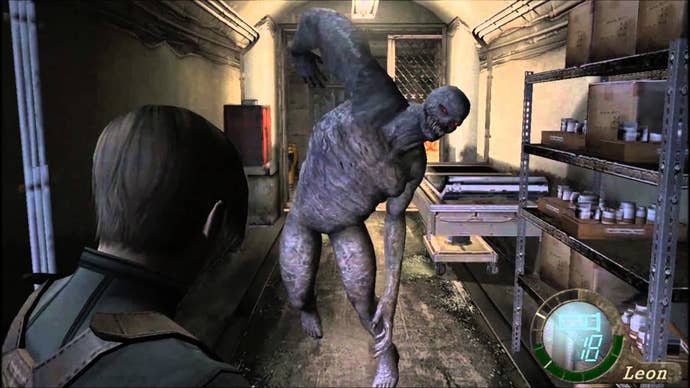
Some variants of the Regenerador are particularly nasty, as they require you to take out all of the parasites in their core, then shoot their legs off to get the Plaga on their back. Some are covered in spikes that can extend and impale you. If you leave a Regenerador on the ground for too long, it'll regenerate its limbs with a horrible sucking sound, or leap at you like a limp grey fish. It's been more than a decade since I first played Resident Evil 4, but such moments remain burned into my memory.
In an issue with Famitsu some years later, Mikami lamented the difficulty of making a survival horror game. "To me, survival horror is a balance between a scary kind of gameplay and the challenge of overcoming that fear. You get a sense of achievement out of that. The fine balance between those two is what makes survival horror. We’re starting to see that kind of game less and less, so I wanted to go back and make what I think is true survival horror."
With the Regeneradors, Resident Evil 4 was able to strike that balance. It offered a monster that could be killed using conventional weapons—a survival horror staple—but also presented it in style that could be described as a "creeping sort of terror." Ultimately, it was emblematic of what worked so well about Resident Evil 4, and why it continues to be one of the most popular (if not the most popular) entries in the series.
Mikami himself, of course, admits that Resident Evil 4 shifted the balance toward the action side of the equation. Mikami told IGN in 2014, "The Resident Evil remake is actually one of my favorites of the series too, but it didn't sell very well. [So] I decided to work more action into Resident Evil 4. [It] would have been a more scary, horror-focused game if the remake had sold well."
He would subsequently characterize modern survival horror games as leaning "too heavily on action." Indeed, Resident Evil 5 would be even more action-focused than Resident Evil 4, to its detriment. That trend would eventually sap away the atmosphere that defined the earlier games and send the series into a funk from which it has only recently managed to recover.
Still, Resident Evil 4's horror chops shouldn't be discounted. It was a game that understood that it was sometimes possible to scare players by simply withholding information. It was full of big, dumb setpieces, but it also had those claustrophobic moments where you would fumble to reload your gun as a Regenerador slouched slowly, inexorably down the hallway.
Resident Evil 4's legacy may be in the way that changed third-person action games, but to me, its scariest moments also remain its finest.





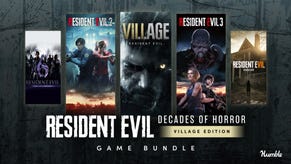

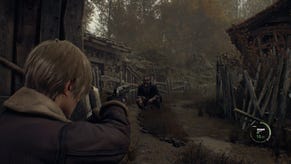
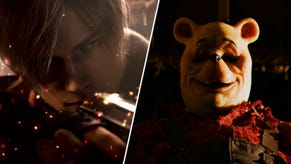
.png?width=291&height=164&fit=crop&quality=80&format=jpg&auto=webp)
.png?width=291&height=164&fit=crop&quality=80&format=jpg&auto=webp)